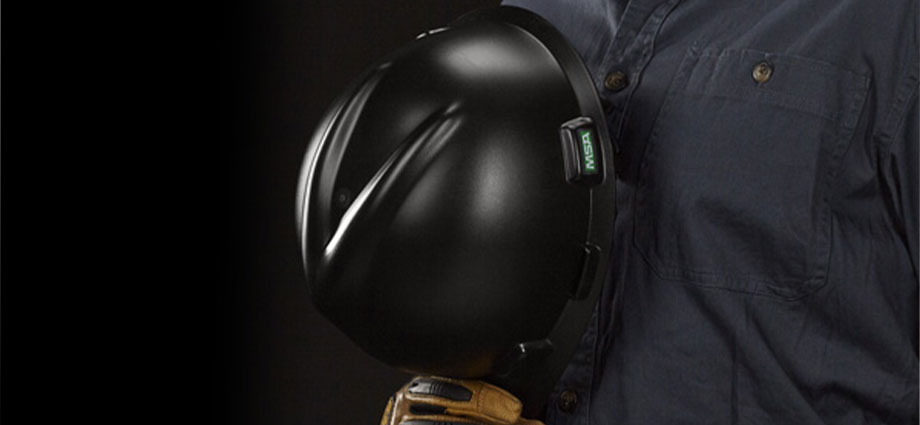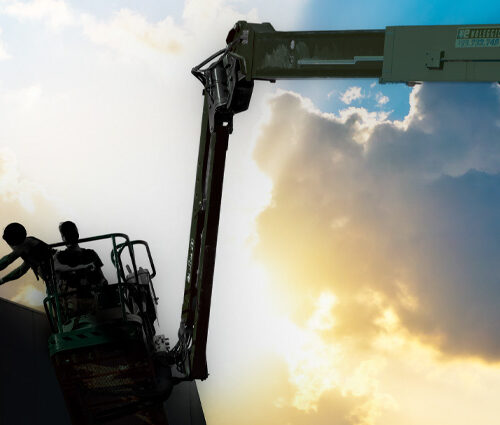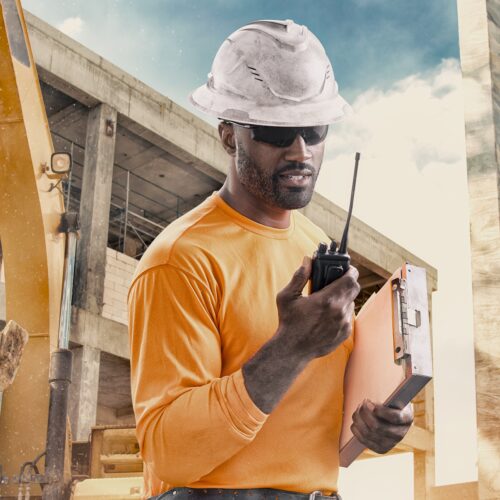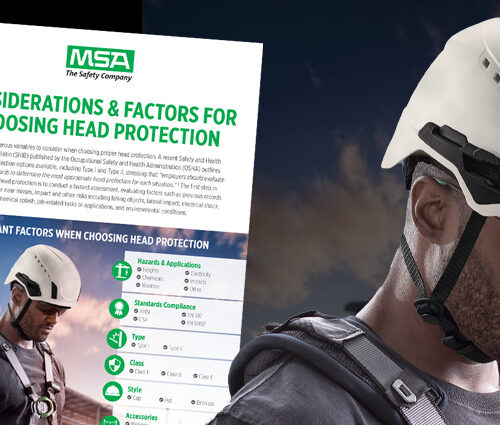
We’ve trained ourselves to look at the label’s expiration date on medicines, milk, bread, and other perishable foods. But we also know that some of these dated consumables can still go bad before their time if not handled properly.
For example, that glass of cold milk can sour quickly if left in the hot sun.
Did you know hard hats have an “expiration date,” too?
And just like food items, their useful life can be shortened if not cared for properly.
Protection against falling or flying objects.
Hard hats — a vital part of your PPE (personal protective equipment) gear — provide protection for the most important part of your body: the brain. In any industry where a potentially damaging impact to the head is possible, hard hats must be used.
The Occupational Safety and Health Administration (OSHA) requires hard hats be used in these occupations … it’s the law.
According to 29 CFR 1910.135(1) for general industry: The employer shall ensure that each affected employee wears a protective helmet when working in areas where there is a potential for injury to the head from falling objects.
29 CFR 1910.135(2) reads: The employer shall ensure that a protective helmet designed to reduce electrical shock hazard is worn by each such affected employee when near exposed electrical conductors which could contact the head.
For the construction industry, 29 CFR 1926.100 applies. It reads: Employees working in areas where there is a possible danger of head injury from impact, or from falling or flying objects, or from electrical shock and burns, shall be protected by protective helmets.
While OSHA doesn’t regulate how hard hats are designed and constructed, it does require their use. The construction, testing, and certification are deferred to Standards ANSI Z89.1-2014 in the United States, and CSA Z94.1-2015 in Canada.
Both categorize and develop testing requirements for hard hats by Type (impact hazard) and Class (electrical hazard).
Simply put, Type I hard hats are tested for top impact only, while Type II must pass testing for both top and lateral impact. As for electrical hazard resistance:
- Class G must withstand 2,200 volts for one minute
- Class E must withstand 12,000 volts for 3 minutes, and
- Class C hard hats are not tested for electrical insulation
Make sure the hard hat you choose to wear is rated for the task at hand.
So, does a hard hat have an “expiration” date?
Technically speaking, the answer is no. After all, we’re not talking about foods, medicines, or even that delicious glass of milk.
That said, most manufacturers have recommendations on helmet and suspension lifespans. MSA hard hat shells should be used no longer than 5 years, while suspensions should be replaced after 12 months. Both are the maximum time frame for replacement, calculated from date of first use.
The date of manufacture is stamped or molded onto the hard hat shell, usually on the underside of the brim. Similarly, the suspension will be marked with the month and year of manufacture, along with the headband size. Remember the recommended replacement date is from the day of first use. Markers or labels can be used to identify the date the hard hat was first placed in service. This helps avoid replacing a sound hard hat too soon.
Depending on the environment, application and use, the shell might need replaced as often as every two years.
Some visible signs of hard hat damage, such as cracks, dents, or holes, are easy to see and are obvious reasons to remove the hard hat from service. But even scores or scuffs on the surface might signal that it’s time to retire it.
If a hard hat has been impacted or penetrated, remove it from service immediately.
Dents from impacts stress the hard hat material, causing weak spots that are not acceptable. Scuffs or scores also weaken it by thinning out the shell. Consider replacement as soon as possible.
If the suspension straps are frayed or ripped, or have damaged stitching, remove the webbing immediately and replace it with a new suspension assembly. Check the plastic attachment clips to make sure they aren’t weakened or broken as well.
Here’s a word of caution, though: When replacing the suspension, or any other attachment for that matter, use only those made by the original manufacturer specifically for that model and size. Hard hats are tested and certified with the manufacturer suspension installed and approved as a system.
Incorrect parts and accessories or those made from any other source render the certification null and void. Additionally, an incorrect headband and web could reduce or eliminate the amount of impact protection. The impact space might not be adequate.
Fading, normally seen in fiberglass or plastic shells, is a sign that sunlight or UV rays have started weakening the shell. This often shows up as a chalky, brittle surface or discoloration.
This can cause brittleness, easily noticed by flexing the brim. Too much flexibility can also be a sign of shell weakness.
Even harsh chemicals or other severe conditions break down the shell material, producing brittleness. This often shows up as fading or discoloration as well. Chemicals can damage the suspension, too.
So, how do you extend the life of this important PPE?
Proper care and use of hard hats.
Nothing lasts forever. But your hard hat is possibly one of the most robust pieces of personal protective equipment you have. Proper care can help to ensure you get the full recommended life from your hardhat and suspension.
First, it’s important to inspect the hard had regularly. And by that, I mean each time you intend to wear it. Be sure to do quick inspections throughout the workday when in a safe place to do so.
Hard hats should be cleaned with an approved cleaner. Our Confidence Plus® cleaning solution or a mild, nondetergent soap and warm water are recommended.
No harsh chemicals or abrasives should be used. Oil-based solvents will deteriorate the shell, so don’t use gasoline or similar products to remove tar, grease and other sticky contaminants. Do NOT use scrapers, knives, or other abrasive tools to remove debris.
Cleaning the headband and webbing in a mild soap and water solution will help to eliminate the buildup of oil and contaminates.
Here’s a quick note about helmet decoration.
Many workers love to show their loyalty to their favorite sports teams or companies like their logo and information displayed on their employees’ hard hats. Is this permissible?
Some paints will attack and damage the shell materials. This reduces the degree of protection the hard hat provides. However, most hard hat manufacturers, including MSA, provide imprinting at time of purchase. They have the proper inks that won’t damage the integrity of the shell and will be resistant to cracking or fading.
Some decals may be used as long as they’re not metallic, the adhesives aren’t damaging to the shell’s composition and are placed no closer than ½” from the helmets edge.
A final recap.
Your hardhat protects the most important part of your body and you want to make sure it is working as hard as you do. Remember to inspect your hard hat for signs that it might need replaced:
- Cracks, dents, and punctures
- Fading, chalkiness, and discoloration
- Loss of flexibility or too much flexing
- Torn, broken, or otherwise damaged webbing components
Your hard hat is a vital part of your PPE. It protects the most valuable organ in your body. Take care of it and it will take care of you.
Use your hard hat whenever there is chance of falling or flying objects. It’s not just the law … it’s the right thing to do.
Additional Resources
- Links on MSA to regulatory information (https://us.msasafety.com/regulatory-information)
- OSHA 29 CFR 1910.135 (https://www.osha.gov/laws-regs/regulations/standardnumber/1910/1910.135)
- OSHA 29 CFR 1926.100 (https://www.osha.gov/laws-regs/regulations/standardnumber/1926/1926.100)
- MSA Hard Hat Customization Services (PDF download) (http://s7d9.scene7.com/is/content/minesafetyappliances/0617-03-MC_LogoExpress)
- MSA Helmet Care and Use FAQ (PDF download) (http://s7d9.scene7.com/is/content/minesafetyappliances/Helmet%20Care%20and%20Use%20FAQ%20-%20EN)








